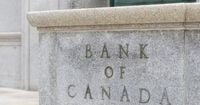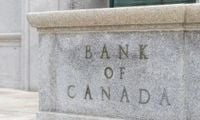On April 16, 2025, the Bank of Canada (BoC) announced it would maintain its key interest rate at 2.75 percent, marking a significant moment as it is the first time the central bank has refrained from changing the rate after seven consecutive cuts since June 2024. This decision comes amid ongoing uncertainties in global trade, particularly influenced by shifting U.S. trade policies.
The BoC's announcement also indicated that the Bank Rate would remain at three percent, while the deposit rate was held steady at 2.70 percent. The central bank's cautious approach reflects the complex interplay of factors affecting the Canadian economy. In a news release, the BoC stated, "The major shift in direction of U.S. trade policy and the unpredictability of tariffs have increased uncertainty, diminished prospects for economic growth, and raised inflation expectations." This sentiment underscores the challenges facing Canadian policymakers as they navigate a turbulent economic landscape.
In recent months, the Canadian economy has experienced notable volatility. The Bank of Canada highlighted several risks it is monitoring, including the impact of higher tariffs on demand for Canadian exports, the spillover effects of trade conflicts on business investment and employment, and the pace at which cost increases due to tariffs are passed on to consumers. The central bank's decision to pause after consecutive rate cuts reflects its need for more clarity on these issues.
Inflation rates have also played a critical role in the BoC's decision-making process. According to Statistics Canada, inflation eased to 2.3 percent in March 2025, largely due to lower gas prices and decreased travel to the U.S. This cooling of inflation provides a brief respite but is expected to rise again in the coming months, as indicated by the BoC. Governor Tiff Macklem noted, "The dramatic protectionist shift in U.S. trade policy and the chaotic delivery have increased uncertainty, roiled financial markets, diminished global growth prospects and raised inflation expectations."
Furthermore, the central bank's analysis includes two potential scenarios for the Canadian economy moving forward. The first scenario suggests that if tariffs are negotiated away quickly, the economy could stall with limited damage, leading to inflation easing to around 1.5 percent for most of the year. Conversely, the second scenario envisions a prolonged trade war that could result in a recession, with inflation rates exceeding three percent in 2026. This latter outcome would have severe and lasting consequences for the Canadian economy, as the U.S. tariffs could permanently diminish Canada’s potential output and standard of living.
The BoC's recent decisions come on the heels of significant economic challenges. Employment figures showed a decline in March, and businesses are reportedly slowing their hiring plans due to the ongoing trade tensions. Wage growth has also shown signs of moderation, further complicating the economic recovery. The central bank's forecasts reflect the precarious nature of the current economic climate, with Macklem emphasizing, "The future is no clearer. We still do not know what tariffs will be imposed, whether they’ll be reduced or escalated, or how long all of this will last."
As the Bank of Canada navigates these uncertain waters, the next interest rate announcement is scheduled for June 4, 2025. Economists and analysts are closely watching the situation, as the BoC signaled it would proceed carefully in setting future rates. The central bank will be monitoring how much the tariffs reduce demand for Canadian exports, dampen business and consumer spending, and how quickly new costs are passed on to customers.
In the broader context, the implications of the BoC's decision extend beyond mere numbers. The central bank's caution reflects a deep concern for the overall health of the Canadian economy in the face of external pressures. The ongoing U.S.-Canada trade relationship, coupled with domestic economic factors, creates a complex environment for monetary policy.
The BoC's recent rate decision also comes at a time when Canadian consumers and businesses are feeling the strain of economic uncertainty. The real estate market has shown signs of weakening, as prospective buyers grow hesitant amid fluctuating market conditions. Retail sales have also been affected, with reports indicating that firms are already trimming their workforce in response to the changing economic landscape.
Despite the decision to hold rates steady, some economists believe that further rate cuts may be necessary if economic conditions do not improve. TD economist James Orlando noted that the tone of the announcement seemed consistent with a potential cut, highlighting the downside risks to the economy. He stated, "It highlighted the downside risks to the economy, with both scenarios showing a level of weakness that is deserving of further rate cuts."
As the Bank of Canada continues to assess the evolving economic situation, the focus will remain on understanding the implications of U.S. trade policies and their impact on Canadian economic growth. The central bank's commitment to monitoring inflation expectations and economic indicators will be crucial in determining its future policy direction.
In summary, the Bank of Canada's decision to maintain its key interest rate at 2.75 percent reflects a cautious approach amid significant global trade uncertainties. With inflation rates cooling but expected to rise again, and employment figures showing signs of weakness, the central bank is poised to navigate a complex economic landscape in the months ahead.







